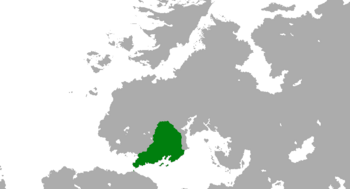Ardaima
League of Ardaima Lega di Ardaima | |
|---|---|
| Motto: ″Ab Uno Multis″ | |
 | |
| Capital | Cadamia (administrative) |
| Largest | San Fausto |
| Official languages | Arday |
| Demonym(s) | Ardaiman |
| Government | Federal directorial oligarchic republic |
• Archbishop of San Alanso | Camillo Benso |
• Secretary (Praesesian) | Pietro Verri |
• Secretary (Unitarian) | Francesco Melzi d'Eril |
• Secretary (Statale) | Giuseppe Parini |
| Legislature | Uniform Orders of Ardaima |
| Custodia | |
| Congress of Deputies (Congresso Deputato) | |
| History | |
• Independence from Fiorentina | 482 CE |
• Mardimon Kingdom | 568 |
• City-states | 780 |
• Kingdom of Ardaima | 1645 |
• Grand Regency | 1899 |
• League of Ardaima | 1928 |
| Area | |
• Total | 370,340 km2 (142,990 sq mi) |
• Water (%) | 5 |
| Population | |
• 2018 estimate | 67,748,116 |
• 2010 census | 64,360,710 |
| GDP (PPP) | estimate |
• Total | 2.440 trillion |
• Per capita | 36,030 |
| HDI | 0.880 very high |
Ardaima, officially the League of Ardaima and also called the Marble Coast (Arday: La Costa di Marmo), is an Asuran along the coast of the Mediterranean sea and traversed along its northern length by the Arzvan Mountains. Ardaima has a largely temperate seasonal climate. The country covers an area of 370,340 km2 (230,118 sq mi) and shares open land borders with Midrasia, Arzva, and Aramas as well as the micro-state of Alforja. Ardaima has maritime exclaves in the form of Torcello and the South Troping peninsula. With around 67 million inhabitants, Ardaima is the fourth-most populous state in Asura.
Due to its central geographic location as a bridge between Arabekh and Asura, Ardaima has historically been home to a myriad of ancient peoples and cultures. Small chiefdoms made up of groups such as the Gravines, Ceprans, Addaurii flourished in this region and are recorded by the Artakhshathran empire during their conquests in the early 4th century BCE. While the Artakhshathrans destroyed the native kingdoms, they also brought about a flowering of urban society on the southern coast of Asura. Notably, Ardaima’s eastern border with Midrasia, what is now Riveria, was home to many great cities which quickly came to dominate their surrounding territory under the Kingdom of Fiorentina. The Fiorentines went on to establish their titular empire, which included all of modern Ardaima. After the fall of the Fiorentines, land was divided back into competing petty kingdoms.
During the middle ages, there was substantial conflicts between the Alydians in the east and the Druidry of the west. The Alydianization, both by conversions and by conquest, of Ardaima, however, came to be a major cultural factor that divided the Paithwaidhs from the Ardaimans. As a result of their separation from tir Lhaeraidd, they were often victims of raids from their erstwhile brothers. The zealous Ardaimans came to the aid of Laterna in the Northern Crusades and knights such as Gregorio the Gold and Tommaso Yellowtails, both from Sidico, became paragons of Ardaiman chivalry. The Ardaiman cities did also found a niche in their production of fine luxury goods such as ceramics, glassware, lace and silk. The wealthy of these cities brought about a flowering of science, technology, and art that spread through the world.
The 17th century republican reformation had some substantial effects on Ardaima. The liberation of the serfs, the creation of deliberative constitutional bodies to advise monarchs, and even a few bloody depositions marked the period. Perhaps more important, however, was the Fiorentine rival which coincided with the rise of the Protecteurs. Many factions, both in the clergy and the nobility, sought a return to the classical lifestyle. At the same time that serfs were being liberated for the first time, land was re-centralized into latifundia that would come to dominate the rural regions. In the cities, forums were built to encourage philosophical discourse, and the first inklings of empire began to appear in Ardaima. The royal period of Ardaima, lasting from the early eighteenth to the mid-nineteenth centuries. The newly crowned King had relatively little effect on the many cities of Ardaima, except that an end to the fighting over who would become King sparked an economic recovery that made the royal period into a mini golden age, or “La Bellissima Epoca” as modern Ardaiman Deverallistes often refer to it.
History
Geography
Climate
Environment
Politics and Government
Ardaima is a league of city-states and their associated territories. The League is governed by the Treaty of San Illa, which established a committee to administrate the shared rights and responsibilities of the states. The primary components of the treaty were a common market, a common currency, and a common defense force. The market has grown to include a number of corollaries which have established work safety standards, consumer protections, and a mutually recognized education system. The market is overseen by the Labor & Commerce Directory, which has a special panel of eleven members, one from each state. The League Reserve Bank is overseen in a similar fashion. There are offices of both organizations in every state, but the primary offices are all located in Cadmaria and generally tend to decide on best practices for other locations.